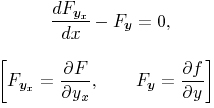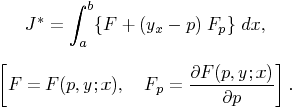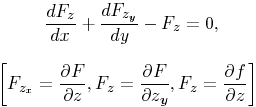1 2 3 4 5 6 7 8 9 10 |
||||||||
23.
Further development of the methods of the calculus of variations
So
far, I have generally mentioned problems as definite and special as
possible, in the opinion that it is just such definite and special
problems that attract us the most and from which the most lasting
influence is often exerted upon science. Nevertheless, I should like to
close with a general problem, namely with the indication of a branch of
mathematics repeatedly mentioned in this lecture--which, in spite of the
considerable advancement lately given it by Weierstrass, does not receive
the general appreciation which, in my opinion, is its due--I mean the
calculus of variations.50 The
lack of interest in this is perhaps due in part to the need of reliable
modern text books. So much the more praiseworthy is it that A. Kneser in
a very recently published work has treated the calculus of variations
from the modern points of view and with regard to the modern demand for
rigor.51
The
calculus of variations is, in the widest sense, the theory of the
variation of functions, and as such appears as a necessary extension of
the differential and integral calculus. In this sense, Poincaré's
investigations on the problem of three bodies, for example, form a
chapter in the calculus of variations, in so far as Poincaré derives
from known orbits by the principle of variation new orbits of similar
character. I
add here a short justification of the general remarks upon the calculus
of variations made at the beginning of my lecture. The
simplest problem in the calculus of variations proper is known to consist
in finding a function y of a variable x such that the
definite integral
assumes a minimum
value as compared with the values it takes when y is replaced by
other functions of x with the same initial and final values. The vanishing of
the first variation in the usual sense
gives for the
desired function y the well-known differential equation
In order to
investigate more closely the necessary and sufficient criteria for the
occurrence of the required minimum, we consider the integral
Now we inquire
how p is to be chosen as function of x, y in order that the value of this
integral J* shall be independent of the path of integration, i. e., of
the choice of the function y of the variable x.
The integral J* has the form
where A and B
do not contain y, and the vanishing of the first variation
in the sense which
the new question requires gives the equation
i. e.,
we obtain for the function p of the two variables x, y the
partial differential equation of the first order
The ordinary
differential equation of the second order (l) and the partial
differential equation (1*) stand in the closest relation to each other.
This relation becomes immediately clear to us by the following simple
transformation
We derive from this,
namely, the following facts: If we construct any simple family of
integral curves of the ordinary differential equation (l) of the second
order and then form an ordinary differential equation of the first order
which
also admits these integral curves as solutions, then the function p(x,
y) is always an integral of the partial differential equation (1*) of
the first order; and conversely, if p(x, y) denotes any
solution of the partial differential equation (1*) of the first order,
all the non-singular integrals of the ordinary differential equation (2)
of the first order are at the same time integrals of the differential
equation (l) of the second order, or in short if yx = p(x,
y) is an integral equation of the first order of the differential
equation (l) of the second order, p(x, y) represents an
integral of the partial differential equation (1*) and conversely; the
integral curves of the ordinary differential equation of the second order
are therefore, at the same time, the characteristics of the partial
differential equation (1*) of the first order. In
the present case we may find the same result by means of a simple
calculation; for this gives us the differential equations (1) and (1*) in
question in the form
where the lower
indices indicate the partial derivatives with respect to x, y, p, yx.
The correctness of the affirmed relation is clear from this. The close relation
derived before and just proved between the ordinary differential equation
(1) of the second order and the partial differential equation (1*) of the
first order, is, as it seems to me, of fundamental significance for the
calculus of variations. For, from the fact that the integral J* is
independent of the path of integration it follows that
if we think of the
left hand integral as taken along any path y and the right hand
integral along an integral curve
With the help of
equation (3) we arrive at Weierstrass's formula
where E
designates Weierstrass's expression, depending upon yx, p,
y, x, E(yx, p) = F(yx) - F(p)
- (yx - p) Fp(p), Since,
therefore, the solution depends only on finding an integral p(x,
y) which is single valued and continuous in a certain neighborhood of
the integral curve
The
developments indicated may be transferred without necessitating further
calculation to the case of two or more required functions, and also to
the case of a double or a multiple integral. So, for example, in the case
of a double integral
to be extended over
a given region
gives the well-known
differential equation of the second order
for the required
function z of x and y. On the other hand
we consider the integral
and inquire, how
p and q are to be taken as functions of x, y and z in order that the
value of this integral may be independent of the choice of the surface
passing through the given closed twisted curve, i. e., of the choice of
the function z of the variables x and y. The integral J*
has the form
>and the
vanishing of the first variation
in the sense which
the new formulation of the question demands, gives the equation
i. e.,
we find for the functions p and q of the three variables x,
y and z the differential equation of the first order
If we add to this
differential equation the partial differential equation
resulting from the
equations zx
= p(x, y, z), the partial
differential equation (I) for the function z of the two variables x
and y and the simultaneous system of the two partial differential
equations of the first order (I*) for the two functions p and q
of the three variables x, y, and z stand toward one another
in a relation exactly analogous to that in which the differential
equations (1) and (1*) stood in the case of the simple integral. It follows from the
fact that the integral J* is independent of the choice of the
surface of integration z that
if we think of the
right hand integral as taken over an integral surface z of the
partial differential equations
and with the help
of this formula we arrive at once at the formula
which
plays the same role for the variation of double integrals as the
previously given formula (4) for simple integrals. With the help of this
formula we can now answer the question how far Jacobi's condition in
conjunction with Weierstrass's condition E > 0 is necessary and
sufficient for the occurrence of a minimum. Connected
with these developments is the modified form in which A. Kneser,52
beginning from other points of view, has presented Weierstrass's theory.
While Weierstrass employed integral curves of equation (1) which pass
through a fixed point in order to derive sufficient conditions for the
extreme values, Kneser on the other hand makes use of any simple family
of such curves and constructs for every such family a solution,
characteristic for that family, of that partial differential equation
which is to be considered as a generalization of the Jacobi-Hamilton
equation. The
problems mentioned are merely samples of problems, yet they will suffice
to show how rich, how manifold and how extensive the mathematical science
of today is, and the question is urged upon us whether mathematics is
doomed to the fate of those other sciences that have split up into
separate branches, whose representatives scarcely understand one another
and whose connection becomes ever more loose. I do not believe this nor
wish it. Mathematical science is in my opinion an indivisible whole, an
organism whose vitality is conditioned upon the connection of its parts.
For with all the variety of mathematical knowledge, we are still clearly
conscious of the similarity of the logical devices, the relationship of
the ideas in mathematics as a whole and the numerous analogies in its
different departments. We also notice that, the farther a mathematical
theory is developed, the more harmoniously and uniformly does its
construction proceed, and unsuspected relations are disclosed between
hitherto separate branches of the science. So it happens that, with the
extension of mathematics, its organic character is not lost but only
manifests itself the more clearly. But,
we ask, with the extension of mathematical knowledge will it not finally
become impossible for the single investigator to embrace all departments
of this knowledge? In answer let me point out how thoroughly it is
ingrained in mathematical science that every real advance goes hand in
hand with the invention of sharper tools and simpler methods which at the
same time assist in understanding earlier theories and cast aside older
more complicated developments. It is therefore possible for the
individual investigator, when he makes these sharper tools and simpler
methods his own, to find his way more easily in the various branches of
mathematics than is possible in any other science. The
organic unity of mathematics is inherent in the nature of this science,
for mathematics is the foundation of all exact knowledge of natural
phenomena. That it may completely fulfil this high mission, may the new
century bring it gifted masters and many zealous and enthusiastic
disciples! |






